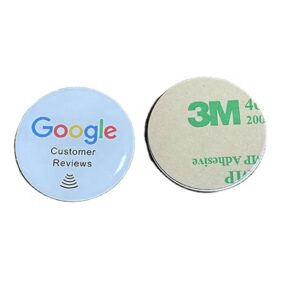Table of Contents
ToggleIntroduction
NFC (Near Field Communication) technology has become increasingly common in our everyday lives, mostly recognized for its role in facilitating easy and secure mobile payments. However, the potential of NFC tags extends far beyond just financial transactions. This article explores six innovative future applications of NFC tags that are poised to transform various aspects of our daily lives.

1. Smart Home Automation
NFC tags can be strategically placed around your home to enhance your smart living experience. Imagine tapping your phone against a tag at your front door to trigger a series of actions: unlocking the door, turning on the hallway lights, and playing your favorite relaxing music. NFC tags could also be placed in bedrooms to switch lighting modes, in the kitchen to activate recipe assistants, and in the living room to manage entertainment systems. This seamless integration can significantly improve convenience and energy efficiency.
2. Enhanced Healthcare
Healthcare is another sector where NFC tags are making significant strides. They can be embedded into patient wristbands for instant access to medical records, ensuring that healthcare providers have up-to-date information at their fingertips. NFC tags can also be used in medication packaging to provide patients with detailed instructions, reminders, and alerts for their prescriptions. This can lead to better patient adherence to medication regimes and overall improved health outcomes.
3. Interactive Retail Experiences
Retailers are exploring creative ways to use NFC tags to enhance customer experiences. By embedding NFC tags within product displays, customers can simply tap their smartphones to receive detailed product information, reviews, and personalized recommendations. Additionally, NFC tags can be used for virtual try-ons of apparel or accessories, creating a more engaging and innovative shopping experience that merges the physical and digital worlds.
4. Improved Travel and Transportation
NFC tags are set to revolutionize the way we travel. Public transport systems are increasingly adopting NFC technology for ticketing, allowing commuters to tap their phones or cards to access services. Hotels and airlines are beginning to use NFC tags for seamless check-ins and access to rooms or lounges. In the future, NFC tags could also be implemented in car rental services, bike shares, and urban navigation systems, making travel more efficient and user-friendly.
5. Dynamic Marketing and Advertisement
Marketers are leveraging NFC tags for higher engagement with their audiences. Posters, flyers, and other physical advertisements equipped with NFC tags can provide instant access to promotional content, discounts, or interactive experiences. By tapping their phones, users can participate in contests, access exclusive content, or even make purchases directly, creating a direct and personalized marketing experience that builds stronger connections between brands and consumers.
6. Streamlined Work Environments
Workplaces of the future are likely to see widespread use of NFC tags to streamline various processes. NFC-enabled employee IDs can simplify access control and attendance logging. Meeting rooms equipped with NFC tags can enable easy booking, control presentation devices, and manage lighting and video conferencing equipment. This can lead to reduced downtime and increased productivity, making office environments more tech-savvy and efficient.
Conclusion
While NFC tags are already making our lives simpler through mobile payments, their potential is far greater and ever-evolving. From smart homes and healthcare to retail, travel, marketing, and workplaces, NFC technology promises to bring about significant changes in the ways we interact with our environment and manage our daily tasks. As technology advances, the applications of NFC tags will only continue to expand, offering more innovative solutions to enhance convenience, efficiency, and connectivity in our everyday lives.
